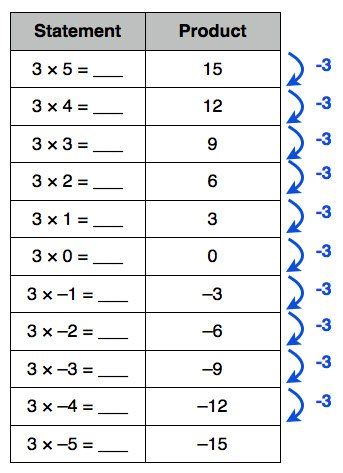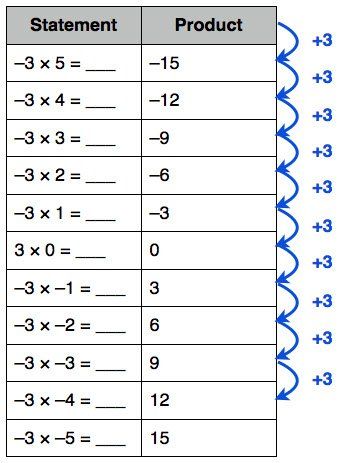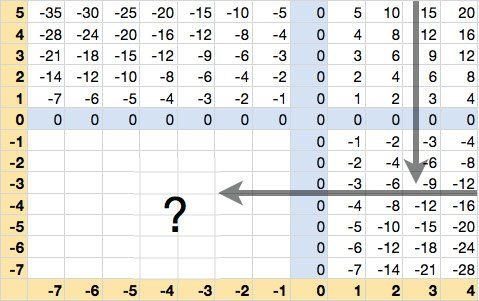Why is a Negative Times a Negative Positive?
If a student is using a repeated addition model of multiplication then it certainly makes sense that a positive number times a positive number is positive. 3 × 5 means three copies of 5, and 5 + 5 + 5 = 15.
Using the repeated addition model, we can even argue that 3 × (-5) means sum three copies of -5, and therefore 3(-5) = (-5) + (-5) + (-5) = -15. (Note that this uses signed addition from 7.NS.1)
-3 × 5 is a bit trickier--what does it mean to have -3 groups of 5? But, here we can argue that, since multiplication is commutative, -3 × 5 = 5 × -3, which would mean 5 groups of -3 each, or (-3) + (-3) + (-3) + (-3) + (-3) = -15.
Finally, how do we deal with -3 × -5? In this case we can’t use the commutative law to justify an answer because that will yield -5 × -3 and we will have the same problem again. There are two possible choices:
- Reason from patterns
- Reason from mathematical properties
Reasoning from patterns: Three Pattern-based Arguments
Reasoning from patterns might look like the following.
1. Problem: -3 × -5
Starting from what we know, we can build this table:
Looking at this table, if we define -3 × -5 = 15, then the table above is symmetrical--there are two positive products and two negative products. Multiplication has other symmetrical properties (e.g., the commutative property), so maybe this should also be symmetrical.
Admittedly this is a fairly weak pattern--three observations is a small data set from which to generalize.
2. Another popular way to explain that a negative times a negative ought to be positive is reasoning from a model showing change over time.
Watch this video showing a jug full of water draining.
Now, what would you see if the video of the water draining was played backward?
Take a look:
This model doesn’t prove that a negative times a negative is a positive, but it does suggest how the combination of two negative quantities--draining water and a film playing in reverse--can combine to make an image of something moving in the positive direction (i.e., the bucket filling).
3. Another pattern-based argument can use the constant differences in multiplication tables. Look at the following multiplication tables:
Since each row is three less than the previous, this first chart helps show (again) why 3 × -5 = -15. Now let’s shift the order using the commutative property again and look at the -3 times tables:
Here, to move from one row to the next, we add three. And, if we continue the pattern past -3 × 0, the results become positive.
Taken together, these two charts provide a pattern-based explanation for why -3 × -5 = 15. On an extended multiplication chart, filling in these two tables would be the same as reading down the 3’s column and then left on the -3’s row.
Reasoning from Mathematical Properties: A Mathematical Argument
The explanations of why minus times a minus is plus may convince you that a negative number times a negative number yields a positive number. However, these are not complete proofs: observing a pattern is not the same as proving a mathematical statement. Let's show it's true using basic properties of our logical system.
We'll begin by showing that (-1) x (-1) = 1. We'll rely on the distributive property of multiplication over addition. It says that
a(b + c) = ab + ac for any real numbers a, b, and c.
We also know that any number plus its opposite is zero. So let's begin there:
1 + (-1) = 0
Now we multiply both sides by (-1). On the right-hand side, zero times (-1) is zero.
(-1) [ 1 + (-1) ] = 0
Now the key step: use the distributive property.
(-1)(1) + (-1)(-1) = 0
But (-1)(1) = (-1) because of identity (any number times 1 is itself), so
(-1) + (-1)(-1) = 0
Now we add one to both sides and simplify
1 + (-1) + (-1)(-1) = 1
(-1)(-1) = 1
Ta-daaa!
Now let's be more general and look at numbers other than -1. We'll look at arbitrary numbers a and b. Let's figure out what (-a)(-b) is. We know that a negative number is just (-1) times that number. So
(-a)(-b) = (-1)(a)(-1)(b)
Now we use the commutative property, rearranging the factors, to say that
(-a)(-b) = (-1)(-1)(a)(b) = (-1)(-1)(ab)
But we just showed that (-1)(-1) = 1, so
(-a)(-b) = ab
Which is what we were trying to show. The product of any two numbers is the product of their opposites.



